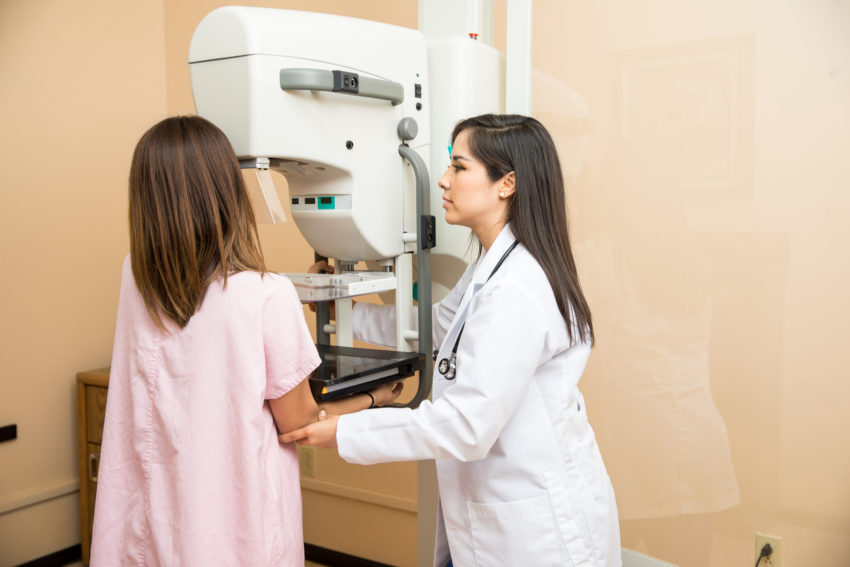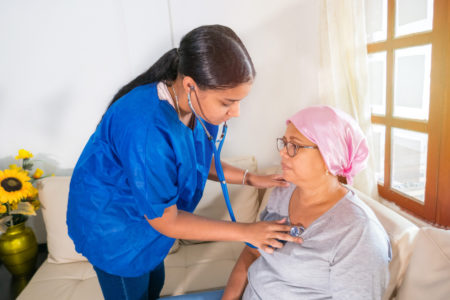
Share On Social!
Latinos face some serious cancer health disparities.
They are so serious that many health experts recommend cancer screening, a type of test that looks for signs of different cancers early, before the illness can cause serious harm.
“Screening tests can help find cancer at an early stage, before symptoms appear,” experts at the National Cancer Institute (NCI). “Early detection is important because when abnormal tissue or cancer is found early, it may be easier to treat. By the time symptoms appear, cancer may have begun to spread and be harder to treat.”
What is Cancer Screening?
Cancer screening is a series of exams, most of the time recommended by a physician or begun at a certain age, to explore the body for any signs of cancer.
According to NCI, types of screening are:
- Physical exam and history: An exam of the body to check general signs of health, including checking for signs of disease, such as lumps or anything else that seems unusual. A history of the patient’s health habits and past illnesses and treatments will also be taken.
- Laboratory tests: Medical procedures that test samples of tissue, blood, urine, or other substances in the body.
- Imaging procedures: Procedures that make pictures of areas inside the body.
- Genetic tests: A laboratory test in which cells or tissue are analyzed to look for changes in genes or chromosomes. These changes may be a sign that a person has or is at risk of having a specific disease or condition.
Screening tests usually do not diagnose cancer.
“If a screening test result is abnormal, more tests may be done to check for cancer. For example, a screening mammogram may find a lump in the breast. A lump may be cancer or something else. More tests need to be done to find out if the lump is cancer,” according to NCI. “These are called diagnostic tests. Diagnostic tests may include a biopsy, in which cells or tissues are removed so a pathologist can check them under a microscope for signs of cancer.”
Still, screening can be the difference between life and death for some.
Luckily, many cancers—especially some of the most deadly ones—can be caught early with certain screening tests, according to NCI:
- Breast Cancer. Mammography “has been shown to reduce deaths from the disease among women ages 40 to 74, especially those over age 50.”

- Cervical Cancer. “Women between the ages of 21 and 29 should have a Pap test every 3 years. Women between the ages of 30 and 65 should have both a Pap test and an HPV test (called co-testing) every 5 years, or a Pap test alone every 3 years,” according to the American Cancer Society.”
- Colorectal (Colon) Cancer using colonoscopy, sigmoidoscopy, and stool tests. “Colonoscopy and sigmoidoscopy not only detect colorectal cancer early but also help prevent the disease in the first place.”
- Lung Cancer. Low-dose computed tomography (LDCT) “has been shown to reduce lung cancer deaths among heavy smokers ages 55 to 74.”
Several other screening tests exist, and may be recommended for those at high risk. But they are not as proven as these other tests.
“Screening for ovarian, pancreatic, prostate, testicular, and thyroid external cancers has not been shown to reduce deaths from those cancers,” according to the CDC. “The USPSTF found insufficient evidence to assess the balance of benefits and harms of screening for bladder cancer and oral cancer in adults without symptoms, and of visual skin examination by a doctor to screen for skin cancer in adults.”
The American Cancer Society suggests “informed decision-making” about screening tests, including prostate cancer screening through a PSA blood test.
“This means men should discuss the possible risks and benefits of prostate cancer screening with a health care provider before deciding whether to be screened,” according to the agency.
Why Does Cancer Screening Matter for Latinos?
Latinos are screened less often than same other racial/ethnic groups, despite high rates of cancer and/or worse outcomes among this demographic.
In fact, of the cancers that can be screened:
- Breast cancer is the leading cause of death in Latinas. While breast cancer death rates have declined in recent years, the rate of decline among Latinas is lower (1.1% per year) than their white peers (1.8% per year).
- Latinas are 40% more likely to be diagnosed with cervical cancer, and 20% more likely to die from cervical cancer, compared to their white peers, the U.S. Department of Health and Human Services’ Office of Minority Health states
- There is a statistically significant disparity in stage-specific mortality of colon cancer by race, with a higher proportion of deaths from metastatic disease among Latinos than whites (48% vs. 44% respectively), a study published in Oncotarget states.
“Cancer is the leading cause of death among Hispanics/Latinos,” a study published in the Cancer Journal for Clinicians states. “An estimated 149,100 new cancer cases and 42,700 cancer deaths will occur among Hispanics in the continental United States and Hawaii in 2018.”
Despite these unfortunate numbers, less Latinos are screened for cancer than their racial peers.
According to an American Society report, among the cancers which can be screened:
- The prevalence of mammography screening within 2014-2013 among women 40 years of age or older was 61% in Latinos compared to 65% in whites
- The prevalence of cervical cancer screening among uninsured Latina women (67%) is higher than among uninsured white women (61%)
- In 2015, CRC screening prevalence among Latinos (50%) was substantially lower than among whites (65%) among adults 50 years of age and older
- Colon Cancer testing rates in 2015 were higher in whites (37%) compared to Latinos (26%).
- Among all races combined, the prevalence of screening for lung cancer for both 2010 and 2015 was low (less than 5%)
“Latinos with lung cancer were 13% less likely to be diagnosed early, 2% less likely to receive surgical treatment, and 39% more likely to not receive any treatment compared to white Americans,” according to the American Lung Association.
What Are some Emerging Ways to Increase Cancer Screening for Latinos and Other People of Color?
The need to raise screening rates Latinos is critical.
So much so that organizations across the US are trying new and exciting ways — including using targeted messaging in communities of color to raise screening rates.
One such initiative is NCI’s recent study that sent text and mail messages to raise rates of screening among Black people in Philadelphia.
“Among those in the study who received a single text message reminding them that they were overdue for colorectal cancer screening, only about 2% got screened in the next 12 weeks,” the report states. “But among those who were sent a series of text messages about getting screened and were mailed a fecal immunochemical test (FIT) to use at home, approximately 20% completed the test and returned it by mail over the same time period—a nearly 10-fold increase in screening completion.”
Another study on the U.S.-Mexico border used postcard primers, mailed FIT kits, and live follow-up phone calls to participants with bilingual staff and patient navigation.
“In the trial, nearly 80% of people who received the postcards and FIT kits completed screening. All study participants had an upcoming clinic visit already scheduled … so they were likely a more ‘engaged’ group, according to NCI. “Nevertheless, the trial highlights the importance of using communication strategies developed through academic–community research partnerships to inform the messaging and overall approach for underserved populations.”
Despite having some difficulty engaging individuals who are due for a screening through texting, the mail approach provided a convenient method of screening — which is important to note for potential future messaging campaigns.
Other Emerging Ways to Increase Screening and Health Equity
A study conducted by the American Cancer Society, Iowa Get Screened, Iowa Cancer, Consortium, Upper Midwest Public Health training Center provides Four Essential elements for improving cancer screening rates:
- Make Recommendations
- Develop a Screening Policy
- Be Persistent with Reminders
- Measure Practice Progress
Another report, “Fulfilling the Potential of Cancer Prevention and Early Detection,” which focuses on Colon Cancer, found that using notable figures as advocates can make a difference.
“In recent years, considerable effort has gone into heightening public awareness of colorectal cancer,” the study states. “Much of this has been accomplished by celebrities, a noteworthy example being Katie Couric, a television personality, who has spearheaded an effort to promote screening for colorectal cancer (Gorman, 2000; Newman, 2001). A live television broadcast of her colonoscopy screening examination was associated with a subsequent increase in requests for screenings and referrals to gastroenterologists.”
The American Journal of Managed Care found that making the process as easy as possible can impact rates of screening across cancers.
“Better and more convenient screening tools for a variety of cancer types will help us achieve the targets set forth by leading healthcare organizations,” the study states. “Screening for common cancers is generally cost effective, and an increase in screening rates accompanied by earlier detection of cancer and improved treatment regimens offer the potential to reduce the cancer-related healthcare cost burden through improving outcomes and survival.”
Another way we can advocate for health equity is by downloading a Health Equity Report Card.
The Health Equity Report Card by Salud America! at UT Health San Antonio lets you see many local children are living in poverty and food deserts, what access to education and healthcare your neighbors have, and how many households get access to SNAP food benefits.
Then you can email your Health Equity Report Card to community leaders, share it on social media, and use it to make the case to address inequities where help is needed most!
By The Numbers
142
Percent
Expected rise in Latino cancer cases in coming years



